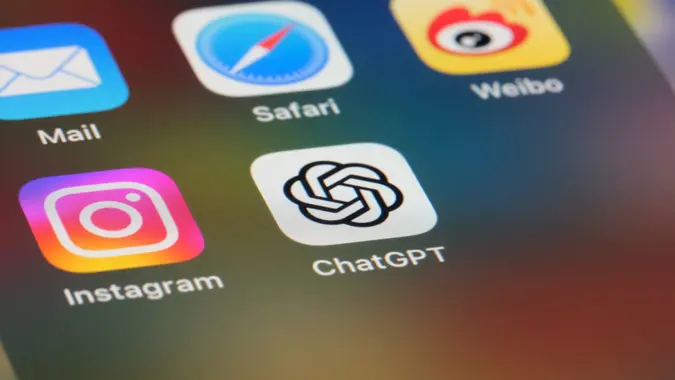Rachel Cruze: 5 Quick Ways To Cut Costs (Even If You Love Spending)

Commitment to Our Readers
GOBankingRates' editorial team is committed to bringing you unbiased reviews and information. We use data-driven methodologies to evaluate financial products and services - our reviews and ratings are not influenced by advertisers. You can read more about our editorial guidelines and our products and services review methodology.

20 Years
Helping You Live Richer

Reviewed
by Experts

Trusted by
Millions of Readers
Ongoing concerns about tariffs, inflation and overall financial stability are leading many Americans to reconsider their spending habits. Deloitte Insights data showed that U.S. consumer spending intentions were down by 9% in April 2025.
But following through with cutting expenses can be hard when you’re someone who enjoys spending or often falls for impulse purchases. The thought of going without what you want can keep you stuck in an overspending cycle.
A recent YouTube video from money expert Rachel Cruze discussed five quick ways to cut costs even if you’re a fan of spending. Here’s how you can save money without too much pain.
Use a Monthly Budget
A Pew Research study found that only 59% of Americans felt at least “very confident” about making budgets. This is a problem since not having a clear direction for your money makes it much easier to overspend.
Cruze recommended having a zero-based budget that puts each dollar of income toward specific categories of spending, giving, saving and investing. She also suggested including a miscellaneous spending category for unexpected purchases.
To make budgeting work, don’t let your budgeted expenses exceed your income, and always track your expenses to compare them with your category limits. You can find budgeting apps that handle the tracking and warn you if you’re overspending.
Do a Subscription Cleanout
If you were to add up your monthly subscriptions, you could be spending $100 or more on services you don’t use much. In some cases, you may have simply forgotten to cancel free trials.
Cruze recommended canceling unnecessary subscriptions regardless of the monthly cost. Over time, even canceling $5 to $10 subscriptions can save you a lot and simplify your expenses.
Besides revisiting various streaming subscriptions, reconsider your regular cable TV service. Cruze said she canceled Comcast to save money and found that she already had other ways to watch her favorite shows.
Buy in Bulk
Buying essentials in bulk can help you cut costs regardless of your household size. While Cruze said buying bulk perishables wasn’t ideal for her, you can consider items like paper products, canned goods and toiletries. Consider what you use most and how much space you have to store bulk items.
Even though chains like Sam’s Club, BJ’s Wholesale Club and Costco charge membership fees, you may still come out ahead if you’re saving a lot versus going to regular grocery stores. You’ll want to do price comparisons and consider the potential savings based on the per-unit cost of items.
Cruze gave this example: “A 12-pack of a Kirkland brand at Costco is $2 a roll for paper towels versus a four-pack at Target for $2.50.”
Plan Your Meals
According to Cruze, food is likely the easiest area where you can overspend. Think about the times you opted for a convenient restaurant meal over a cheap lunch at home.
Cruze recommended planning your meals so you can save money by making meals yourself and be less stressed about what you’ll eat each day. She explained you don’t need to have excellent cooking skills or make complex meals.
You could even start simple and make your own coffee. If you usually buy a $6 Starbucks drink before work, you could save $30 each week this way.
Eliminate Impulse Spending
“What’s crazy is the average American, on average, is spending $150 on impulse purchases, and that adds up to $1,800 a year,” Cruze said.
If you love spending, you might often add nonessentials to your cart or buy things based on your emotions rather than needs. Being more intentional about purchases and sticking to your list can help you cut costs without ignoring your needs.
You can also reduce impulse spending by doing a no-spend challenge, using cash, knowing marketing tricks and making yourself wait to think through less urgent purchases.
More From GOBankingRates
- Nearly 1 in 3 Americans Hit by a Costly Holiday Scam, Norton Survey Shows -- How To Avoid This
- Here's What Retirees Wasted the Most Money On in 2025 -- and How To Avoid It in 2026
- How Middle-Class Earners Are Quietly Becoming Millionaires -- and How You Can, Too
- 6 Safe Accounts Proven to Grow Your Money Up to 13x Faster
Sources
- Rachel Cruze (YouTube), “5 Quick Ways to Cut Costs (Even If You Love to Spend).”
- Deloitte Insights, “ConsumerSignals – April 2025.”
- Pew Research Center, “Roughly half of Americans are knowledgeable about personal finances.”
- Ramsey Solutions, “Does Buying in Bulk Really Save You Money?“
- Mass.gov, “Avoiding the Impulse: Tips for Shopping Responsibly.”
 Written by
Written by  Edited by
Edited by 

























